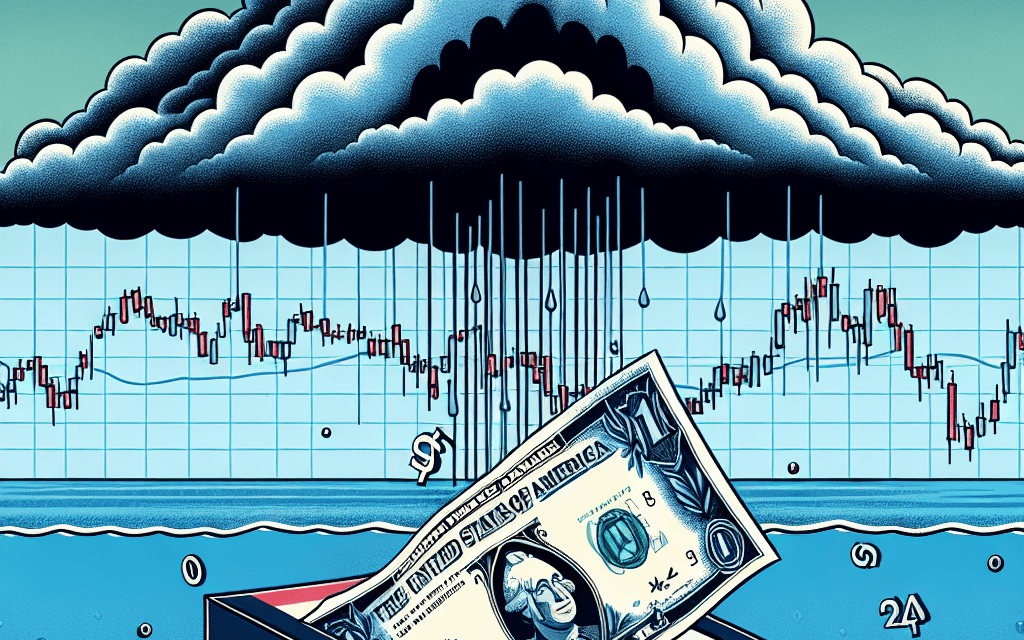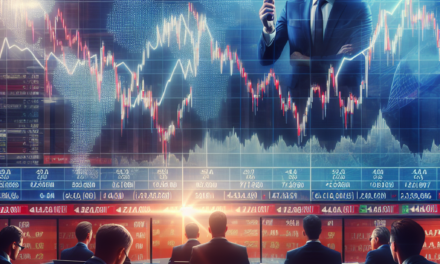“Dollar Dips, Stocks Steady: Navigating Uncertainty as US Election Approaches”
Introduction
As the United States braces for a tightly contested election, financial markets are exhibiting cautious behavior, with the dollar experiencing slight declines and stock markets maintaining a steady course. Investors are closely monitoring the political landscape, aware that the election’s outcome could significantly impact economic policies and market dynamics. The dollar’s dip reflects uncertainty and a potential shift in fiscal and monetary strategies, while the steadiness in stock markets suggests a wait-and-see approach among traders. This period of anticipation underscores the intricate relationship between political events and financial markets, as stakeholders navigate the complexities of a pivotal electoral moment.
Impact Of Tight US Elections On Global Currency Markets
As the United States approaches a tightly contested election, the global currency markets are experiencing notable fluctuations, with the dollar dipping while stocks remain relatively steady. This phenomenon underscores the intricate relationship between political events and financial markets, highlighting the sensitivity of global currencies to the political climate in one of the world’s largest economies. The anticipation of a close election outcome has injected a degree of uncertainty into the markets, prompting investors to reassess their strategies and adjust their portfolios accordingly.
The dollar, often regarded as a safe-haven currency, typically strengthens during periods of global uncertainty. However, the current political landscape in the United States has led to a deviation from this norm. The prospect of a tightly contested election, with potential delays in results and possible legal challenges, has contributed to a decline in the dollar’s value. Investors are wary of the potential for prolonged political uncertainty, which could impact economic policies and, consequently, the strength of the dollar. This apprehension has led to a shift in investor sentiment, with many seeking refuge in other currencies or diversifying their holdings to mitigate potential risks.
In contrast, stock markets have shown a surprising degree of resilience amidst the political uncertainty. While one might expect heightened volatility in equities during such times, the steadiness of stocks can be attributed to several factors. Firstly, investors are banking on the continued support of central banks, which have signaled their commitment to maintaining accommodative monetary policies. This assurance has provided a cushion for equities, as low interest rates and liquidity injections continue to bolster market confidence. Additionally, the global economic recovery, albeit uneven, has contributed to a more optimistic outlook for corporate earnings, further supporting stock prices.
Moreover, the diversification of global markets has played a role in stabilizing stocks. With the rise of emerging markets and the increasing interconnectedness of economies, investors have more options to spread their risk. This diversification has helped mitigate the impact of political uncertainty in any single country, including the United States. As a result, while the dollar faces pressure, stocks have managed to maintain a semblance of stability.
Nevertheless, the interplay between the dollar and stocks remains complex. A weaker dollar can have mixed implications for equities. On one hand, it can boost the competitiveness of U.S. exports, potentially benefiting companies with significant international exposure. On the other hand, a declining dollar may signal broader economic concerns, which could weigh on investor sentiment over time. Thus, while stocks have remained steady for now, the evolving political landscape and its impact on the dollar will continue to be closely monitored by market participants.
In conclusion, the impending tight U.S. election has cast a shadow of uncertainty over global currency markets, leading to a dip in the dollar while stocks have shown resilience. The intricate dynamics between political events and financial markets underscore the importance of understanding the broader implications of such events on global currencies. As investors navigate this uncertain terrain, the interplay between the dollar and stocks will remain a focal point, with potential ramifications for both domestic and international markets. The outcome of the election and its subsequent impact on economic policies will be pivotal in shaping the future trajectory of these markets.
How Political Uncertainty Affects Stock Market Stability
As the United States approaches a tightly contested election, the financial markets are experiencing a period of heightened uncertainty, with the dollar dipping and stocks maintaining a steady course. Political uncertainty is a significant factor that influences market stability, and its effects are particularly pronounced during election periods. Investors, analysts, and policymakers closely monitor these developments, as the outcomes can have far-reaching implications for both domestic and global economies.
Political uncertainty often leads to increased volatility in financial markets. Investors tend to be cautious during such times, as the potential for policy changes can significantly impact economic conditions. In the case of the United States, the stakes are high, given its position as a leading global economic power. The anticipation of shifts in fiscal policy, trade agreements, and regulatory frameworks can lead to fluctuations in investor confidence, which in turn affects market stability. Consequently, the dollar’s recent dip can be attributed to these uncertainties, as investors seek safer assets or hedge against potential risks.
Moreover, the stock market’s steadiness amidst this political uncertainty is noteworthy. Historically, stock markets have shown resilience in the face of political turmoil, often rebounding after initial periods of volatility. This resilience can be attributed to several factors, including the inherent strength of the U.S. economy, the adaptability of businesses, and the forward-looking nature of investors. While short-term fluctuations are common, long-term investors often focus on underlying economic fundamentals rather than transient political events. This perspective helps maintain a degree of stability in the stock market, even as political tensions rise.
In addition to domestic factors, global economic conditions also play a crucial role in shaping market responses to political uncertainty. The interconnectedness of global markets means that political developments in one country can have ripple effects worldwide. For instance, changes in U.S. trade policies or international relations can influence global supply chains, affecting businesses and economies across the globe. As a result, international investors closely watch U.S. elections, as the outcomes can impact their portfolios and investment strategies.
Furthermore, central banks and monetary policy decisions are critical in navigating periods of political uncertainty. The Federal Reserve, for example, plays a pivotal role in maintaining economic stability through its monetary policy tools. By adjusting interest rates and implementing quantitative easing measures, the Fed can influence liquidity and borrowing costs, thereby supporting economic growth and market stability. During election periods, central banks may adopt a cautious approach, carefully balancing the need to support the economy while avoiding actions that could be perceived as politically motivated.
In conclusion, political uncertainty, particularly during tightly contested elections, has a profound impact on stock market stability. While the dollar may experience dips as investors react to potential risks, the stock market often demonstrates resilience, buoyed by strong economic fundamentals and investor confidence. The interplay between domestic and global factors, coupled with the actions of central banks, further shapes market dynamics during these periods. As the U.S. election looms, market participants will continue to navigate this complex landscape, seeking to balance caution with opportunity in an ever-evolving economic environment.
Dollar Dips: What It Means For International Trade
As the U.S. dollar experiences a dip in value amidst a tightly contested election, the implications for international trade are multifaceted and significant. The currency’s fluctuation is not merely a domestic concern but a global one, affecting economies worldwide. A weaker dollar can have both positive and negative consequences for international trade, influencing everything from export competitiveness to import costs.
To begin with, a declining dollar often makes U.S. exports more attractive on the global market. When the dollar weakens, American goods and services become cheaper for foreign buyers, potentially boosting demand. This can be particularly beneficial for U.S. manufacturers and exporters, who may see an increase in sales volume as their products become more competitively priced compared to those from countries with stronger currencies. Consequently, this can lead to a reduction in the trade deficit, as exports rise relative to imports.
However, the benefits of a weaker dollar are not universally felt. For countries that rely heavily on exporting to the United States, a weaker dollar can mean reduced revenue. As the purchasing power of the dollar diminishes, foreign exporters may find that they earn less in their local currency for the same amount of goods sold to the U.S. This can strain economies that are dependent on U.S. markets, potentially leading to broader economic challenges.
Moreover, the impact of a weaker dollar extends to the cost of imports. For American consumers and businesses, a declining dollar means that imported goods become more expensive. This can lead to inflationary pressures as the cost of foreign products, including essential commodities like oil and consumer electronics, rises. Businesses that rely on imported materials may face increased production costs, which could be passed on to consumers in the form of higher prices.
In addition to these direct effects, the dollar’s dip can influence global financial markets. Investors often view the dollar as a safe-haven currency, and its decline can lead to shifts in investment strategies. As the dollar weakens, investors might seek alternative assets, such as gold or other currencies, which can lead to increased volatility in financial markets. This volatility can have ripple effects, impacting everything from stock prices to bond yields.
Furthermore, the timing of the dollar’s dip, coinciding with a tight U.S. election, adds an additional layer of uncertainty. Elections inherently bring unpredictability, and the potential for policy changes can exacerbate market fluctuations. International trade partners may be wary of entering into long-term agreements until the political landscape stabilizes, potentially slowing down trade negotiations and agreements.
In conclusion, while a weaker dollar can provide a temporary boost to U.S. exports, the broader implications for international trade are complex and varied. The increased competitiveness of American goods must be weighed against the potential for inflation and the challenges faced by foreign exporters. As the U.S. election looms, the interplay between political uncertainty and currency fluctuations will continue to be a focal point for economists and policymakers worldwide. Understanding these dynamics is crucial for navigating the intricate web of international trade in an increasingly interconnected global economy.
Strategies For Investors During Election-Induced Market Volatility

As the United States approaches a tightly contested election, investors are bracing for potential market volatility, a common occurrence during such politically charged periods. Historically, elections have been known to induce fluctuations in financial markets, with investors often reacting to the uncertainty surrounding potential policy changes. In this context, the recent dip in the dollar and the steadiness of stock markets serve as a reminder of the complex dynamics at play. For investors, navigating these turbulent waters requires a strategic approach that balances caution with opportunity.
Firstly, it is crucial for investors to maintain a diversified portfolio. Diversification remains a fundamental strategy to mitigate risk, especially during periods of heightened uncertainty. By spreading investments across various asset classes, sectors, and geographies, investors can reduce the impact of volatility in any single area. This approach not only helps in cushioning against potential losses but also positions investors to capitalize on gains in different segments of the market. For instance, while the dollar may experience fluctuations, other assets such as commodities or international stocks might offer stability or even growth.
Moreover, investors should consider the potential implications of different election outcomes on various sectors. Each political party typically has distinct policy priorities that can significantly impact industries such as healthcare, energy, and technology. By analyzing the potential policy shifts, investors can make informed decisions about which sectors might benefit or suffer post-election. For example, a government favoring renewable energy initiatives might boost investments in green technologies, while a focus on deregulation could benefit traditional energy sectors.
In addition to diversification and sector analysis, maintaining a long-term perspective is essential. Market volatility around elections is often short-lived, with historical data showing that markets tend to stabilize after the initial uncertainty subsides. Therefore, investors should avoid making impulsive decisions based on short-term market movements. Instead, focusing on long-term investment goals and maintaining discipline can help weather the storm of election-induced volatility. This approach not only reduces the risk of panic selling but also allows investors to take advantage of potential buying opportunities when prices are temporarily depressed.
Furthermore, staying informed is a critical component of any investment strategy during election periods. Investors should keep abreast of political developments, economic indicators, and market trends to make well-informed decisions. Access to timely and accurate information can provide a competitive edge, enabling investors to anticipate market movements and adjust their strategies accordingly. Engaging with financial advisors or utilizing reliable financial news sources can enhance an investor’s ability to navigate the complexities of election-induced market dynamics.
Lastly, it is important for investors to assess their risk tolerance and adjust their strategies accordingly. Understanding one’s risk appetite can guide decisions on asset allocation and investment choices, ensuring that the portfolio aligns with personal financial goals and comfort levels. During volatile periods, some investors may prefer to adopt a more conservative approach, while others might seek out higher-risk opportunities with the potential for greater returns.
In conclusion, as the US election looms and market volatility becomes a focal point for investors, adopting a strategic approach is paramount. By diversifying portfolios, analyzing sector impacts, maintaining a long-term perspective, staying informed, and assessing risk tolerance, investors can navigate the challenges and opportunities presented by election-induced market fluctuations. Through careful planning and disciplined execution, investors can position themselves to not only protect their assets but also potentially benefit from the dynamic market environment.
Historical Analysis: US Elections And Their Influence On The Dollar
The relationship between US elections and the value of the dollar has long been a subject of interest for economists and investors alike. Historically, the dollar’s performance during election years can be influenced by a myriad of factors, including political uncertainty, economic policies proposed by candidates, and the overall economic climate. As the US election approaches, the dollar has shown signs of dipping, while stock markets remain relatively steady, reflecting a complex interplay of historical trends and current economic conditions.
To understand the current dynamics, it is essential to examine past election cycles and their impact on the dollar. Historically, the dollar tends to experience volatility in the months leading up to an election. This is often due to the uncertainty surrounding potential changes in fiscal and monetary policies, which can affect investor confidence. For instance, during the 2008 election, the financial crisis played a significant role in the dollar’s fluctuations, as investors sought safe-haven assets amidst economic turmoil. Similarly, the 2016 election saw the dollar initially weaken due to uncertainty over trade policies, only to strengthen post-election as markets reacted to anticipated fiscal stimulus.
In contrast, stock markets often exhibit a different pattern. While they too can be volatile, they tend to stabilize as election outcomes become clearer. This steadiness can be attributed to investors’ ability to price in potential policy changes and adjust their portfolios accordingly. For example, during the 2012 election, despite initial jitters, stocks remained relatively stable as investors anticipated continuity in economic policies. This pattern of steadiness amidst uncertainty is evident in the current election cycle, where stocks have maintained a level of resilience despite the dollar’s dip.
The current economic landscape adds another layer of complexity to this historical analysis. The global economy is still grappling with the aftermath of the COVID-19 pandemic, supply chain disruptions, and geopolitical tensions. These factors contribute to the dollar’s recent dip, as investors weigh the potential impact of these issues on future economic policies. Moreover, the Federal Reserve’s monetary policy decisions, particularly regarding interest rates, play a crucial role in influencing the dollar’s value. As the election looms, any indication of policy shifts could further impact the dollar’s trajectory.
Furthermore, the candidates’ economic platforms are pivotal in shaping market expectations. Historically, elections that present stark contrasts in economic policies tend to have a more pronounced impact on the dollar. Investors closely scrutinize candidates’ stances on taxation, government spending, and trade policies, as these can have far-reaching implications for the US economy and, by extension, the dollar. In the current election, the focus on issues such as inflation, fiscal responsibility, and international trade agreements will likely influence the dollar’s performance in the coming months.
In conclusion, while the dollar’s dip and the steadiness of stocks may seem contradictory, they reflect a historical pattern observed in US election cycles. The interplay between political uncertainty, economic policies, and broader economic conditions creates a complex environment for both the dollar and stock markets. As the election approaches, investors will continue to navigate this landscape, drawing on historical insights to inform their strategies. Ultimately, the outcome of the election will play a decisive role in shaping the future trajectory of the dollar and its influence on global markets.
The Role Of Central Banks Amidst Political Uncertainty
As the United States approaches a tightly contested election, the financial markets are exhibiting a cautious stance, with the dollar experiencing a dip while stocks remain relatively steady. This scenario underscores the intricate interplay between political uncertainty and economic stability, a dynamic that central banks are acutely aware of and actively manage. Central banks, particularly the Federal Reserve in the United States, play a pivotal role in navigating the economic waters during such periods of political ambiguity. Their actions, or sometimes deliberate inaction, can significantly influence market sentiment and economic outcomes.
In times of political uncertainty, central banks often find themselves in a delicate balancing act. On one hand, they must ensure that monetary policy remains conducive to economic growth and stability. On the other hand, they must be prepared to respond to any financial disruptions that may arise from political developments. The recent dip in the dollar, juxtaposed with the steadiness of stock markets, highlights the nuanced approach central banks must adopt. A weaker dollar can be attributed to investor caution, as they hedge against potential volatility by diversifying their portfolios. Meanwhile, the steadiness in stock markets suggests a level of confidence that central banks will act as a stabilizing force, ready to intervene if necessary.
Moreover, central banks are tasked with maintaining clear communication to manage market expectations effectively. During election periods, when uncertainty is heightened, the clarity and consistency of central bank messaging become even more crucial. Investors and market participants closely scrutinize statements from central bank officials for any hints of policy shifts or economic outlooks. This scrutiny places additional pressure on central banks to articulate their strategies with precision, ensuring that their intentions are not misinterpreted, which could exacerbate market volatility.
Furthermore, central banks must also consider the global implications of their policies. The interconnectedness of the global economy means that political events in one country can have ripple effects across international markets. As such, central banks often engage in dialogue with their counterparts around the world to coordinate responses and mitigate potential global economic disruptions. This collaborative approach is essential in maintaining financial stability, particularly when political events in major economies like the United States have the potential to impact global markets.
In addition to their traditional monetary policy tools, central banks may also employ unconventional measures to address political uncertainty. These measures could include forward guidance, where central banks provide explicit indications of their future policy intentions, or quantitative easing, which involves large-scale asset purchases to inject liquidity into the economy. Such tools can help reassure markets and provide a buffer against potential economic shocks stemming from political developments.
In conclusion, as the United States faces a tight election, the role of central banks becomes increasingly significant in maintaining economic stability amidst political uncertainty. Their ability to balance monetary policy, communicate effectively, and coordinate internationally is crucial in navigating these challenging times. While the dollar may dip and stocks remain steady, the underlying confidence in central banks’ capacity to manage economic risks is a testament to their pivotal role in the global financial system. As the election unfolds, all eyes will remain on central banks, whose actions will undoubtedly shape the economic landscape in the months to come.
Navigating Currency Fluctuations In A Pre-Election Economy
As the United States approaches a tightly contested election, the financial markets are experiencing a period of heightened uncertainty, with the dollar dipping while stocks remain relatively steady. This dynamic environment presents both challenges and opportunities for investors and policymakers alike. Understanding the interplay between currency fluctuations and the broader economic landscape is crucial for navigating this pre-election period.
The dollar’s recent decline can be attributed to several factors, including market anticipation of potential policy shifts depending on the election outcome. Investors are closely monitoring the candidates’ economic platforms, which could significantly impact fiscal and monetary policies. A change in administration might lead to alterations in trade agreements, tax policies, and government spending, all of which can influence the strength of the dollar. Consequently, market participants are adjusting their positions in anticipation of these potential changes, leading to fluctuations in the currency’s value.
Meanwhile, the stock market has shown remarkable resilience, maintaining a steady course despite the looming election. This stability can be partly explained by the diverse nature of the stock market, which comprises various sectors that may react differently to political developments. For instance, technology and healthcare stocks have continued to perform well, driven by ongoing innovation and demand, while sectors more sensitive to regulatory changes, such as energy and finance, have experienced more volatility. Investors are thus diversifying their portfolios to hedge against potential risks, contributing to the overall steadiness of the stock market.
Moreover, the Federal Reserve’s monetary policy plays a pivotal role in shaping market dynamics during this period. The central bank’s commitment to maintaining low interest rates and providing liquidity to the financial system has bolstered investor confidence, supporting both the stock market and the broader economy. However, the Fed’s actions are also influenced by the political climate, as policymakers must consider the potential economic implications of the election outcome. This delicate balance underscores the interconnectedness of monetary policy and political developments, further complicating the landscape for investors.
In addition to domestic factors, global economic conditions also impact currency and stock market movements. The ongoing recovery from the COVID-19 pandemic, coupled with geopolitical tensions and trade negotiations, adds another layer of complexity to the financial markets. As the world economy gradually rebounds, shifts in global demand and supply chains can affect the dollar’s value and stock market performance. Investors must therefore remain vigilant, considering both domestic and international factors when making investment decisions.
In this pre-election economy, effective risk management is essential for navigating currency fluctuations and market uncertainties. Diversification remains a key strategy, allowing investors to spread risk across different asset classes and sectors. Additionally, staying informed about political developments and potential policy changes can help investors anticipate market movements and adjust their strategies accordingly. By maintaining a balanced approach and being prepared for various scenarios, investors can better position themselves to weather the uncertainties of this election period.
In conclusion, as the US election approaches, the interplay between currency fluctuations and stock market stability presents a complex yet navigable landscape for investors. By understanding the factors driving these movements and employing sound risk management strategies, market participants can effectively navigate the challenges and opportunities of this pre-election economy. As always, staying informed and adaptable will be key to successfully managing investments during this period of heightened uncertainty.
Q&A
1. **What is the current trend of the US dollar?**
– The US dollar is experiencing a dip in value.
2. **How are the stock markets behaving?**
– Stock markets are steady, showing little movement.
3. **What is the main reason for the current market conditions?**
– The tight US election is creating uncertainty, affecting market conditions.
4. **How does the election impact investor behavior?**
– Investors are cautious and hesitant, leading to reduced market volatility.
5. **What sectors are most affected by the election uncertainty?**
– Financial and technology sectors are particularly sensitive to election outcomes.
6. **Are there any safe-haven assets gaining attention?**
– Gold and government bonds are attracting investors seeking stability.
7. **What is the outlook for the markets post-election?**
– Market volatility is expected to increase as election results become clearer.
Conclusion
The impending tight US election has led to a dip in the dollar, while stock markets remain steady. This reflects investor uncertainty and cautious sentiment as they await the election outcome, which could significantly impact economic policies and market dynamics. The stability in stocks suggests that investors are holding their positions, anticipating potential volatility but not yet reacting drastically. Overall, the financial markets are in a state of watchful waiting, with the dollar’s decline indicating concerns over future fiscal and monetary policy directions.





